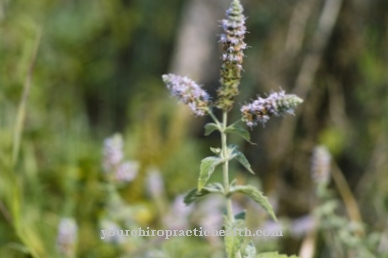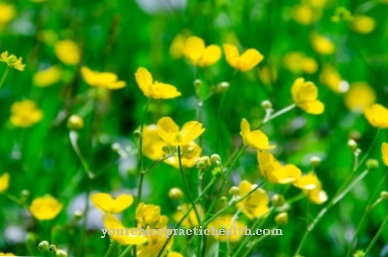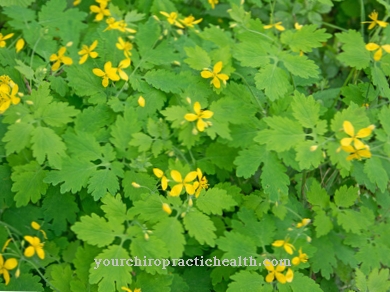The Mountain laser herb is also as Mountain cumin known and occurs mainly in central and southern European mountains. The herb tastes similar to caraway and fennel and has been used in the past for kidney problems, coughs, poisoning, eye problems and gastrointestinal complaints. Meanwhile, mountain cumin is hardly used any more.
Occurrence and cultivation of the mountain laser herb

The umbelliferae are an order of the flowering plants that is distributed worldwide and comprises seven families with a total of approximately 500 genera and 5500 individual species. One of these genera is the umbelliferae, to which the laser herbs belong. This is a type of plant from this genus Mountain laser herb. All types of laser herb grow as perennial herbaceous plants with a strong hollow stem.
The mountain laser herb is a deciduous and perennial herbaceous plant that measures between 30 and 150 centimeters and is sometimes referred to as mountain cumin. The bare stem has fine grooves and a round cross-section with a tuft of fibers that attaches to the base. The vegetative parts are blue-green in color. The basal sheets are on average up to 50 centimeters long. The leaves of the stem get smaller towards the top and have a triangular outline.
The edge of the lanceolate pinnate sections on the petals is light to white in color. The inflorescence is double-gold and has between 20 and 50 rays. The plant is native to the European mountains, especially in the mountains of Central and Southern Europe. The plant species is said to love warmth and prefers sunny slopes or forest edges, where it grows mainly on limestone soils. In Germany, mountain cumin grows primarily in the Alps and the Eifel.
Effect & application
In the past, the mountain laser herb was used both as an aromatic plant and as a medicinal plant. The fruits of the herb taste bitter and smell similar to fennel or caraway seeds. Compared to these plants, however, the herb has a much bitter and sharper taste. In the 9th century, mountain cumin was still one of the most important medicinal plants.
At that time, Charlemagne issued an ordinance known as "Capitulare de Villis". The regulation contains the 89 most important medicinal herbs and also lists mountain cumin. According to the regulation, the mountain laser herb should be planted on the country estates. Charlemagne wanted to ensure a basic supply of medicinal plants and create a natural pharmacy, so to speak. The herb was popular until the late Middle Ages.
In the 16th century, doctors in particular used the plant, which in its effects is similar to caraway and fennel. Caraway is used in the form of dried and ripe fruits as well as caraway oil and consists largely of active ingredients such as essential oils with carvone, limes, phellandrene and other monoterpenes. Phenol carboxylic acids and flavonoids are also found in caraway seeds.
The effect is to stimulate the digestive glands. Antispasmodic properties are associated with caraway seeds. Caraway is still used today for digestive disorders, flatulence or a feeling of fullness and cramps in the stomach, intestines and gall bladder. Caraway seeds are drunk as a tea or used as an essential oil.
The oil in particular has antimicrobial properties and is used in mouthwash and toothpaste. In addition, bad breath disappears when ripe caraway seeds are chewed. In each of the contexts mentioned, the mountain laser herb was also used until the Middle Ages. In addition, the mountain laser herb was associated with the effects of fennel, the herb and fruits of which stimulate milk secretion and the flower stalks of which are considered beneficial for the bladder and kidneys.
Fennel was used in addition to the mucus solution. The medicinal plant was also used for eye problems and intoxication. The plant is considered to strengthen the stomach and intestines. The effect is said to relieve abdominal pain, colic, stomach cramps, cough and chest affections. The plant also has a calming effect.
Importance for health, treatment & prevention
Due to this intense taste under the difficult cultivation, they are now rarely grown. Even in the wild, they are currently extremely rare. This means that their use has now decreased. The fact that mountain cumin no longer plays a role in today's medicine in the western world has, in addition to its low occurrence, above all to do with the alternatives.
It is now no longer necessary to struggle with cultivating the plant in order to be able to fall back on a suitable medicinal plant for gastrointestinal problems, kidney problems or eye problems. Since the herb does not differ in its mode of action from real caraway or fennel, these two plants are a suitable substitute. They are easier to handle in cultivation and are also still widespread in the wild.
An added benefit of these alternatives is the taste. Because of its intense bitter taste and spiciness, mountain cumin has never been an ideal medicinal plant, especially for children. Caraway and fennel provide almost the same medicinal substances and active ingredients with a much more pleasant taste and are therefore much better suited for consumption. For this reason, the two alternatives have almost completely supplanted the mountain laser herb.
The medically declining relevance of the mountain laser herb is also reflected in modern books on medicinal plants. Hardly any modern book on medicinal plants still contains mountain cumin. Nonetheless, from the eighth century onwards, mountain cumin was of proven medical relevance, which continued into the Middle Ages. As the traditional ordinance of Charlemagne makes clear, the plant's relevance was so great that agriculture was officially asked to cultivate it.
























.jpg)



